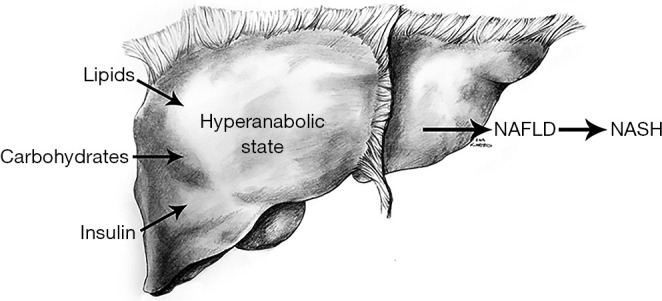Figure 2.

Lipids: insulin resistance causes decreased glucose delivery to tissues leading to peripheral lipolysis and increased free fatty acids in the bloodstream. Carbohydrates: excess carbohydrate consumption and decreased glucose uptake by insulin resistant muscle and adipose tissue leads to increased hepatocyte exposure to blood glucose. Insulin: as muscle and adipose tissue develop decreased insulin sensitivity, pancreatic beta cells secrete increasing levels of insulin to maintain blood glucose level homeostasis. Hyper-anabolic state: the liver maintains greater insulin sensitivity than adipose or skeletal-muscle tissue. The liver is exposed to increased blood glucose, free fatty acid, and insulin levels. NAFLD: insulin drives hepatic uptake of free fatty acids and carbohydrates. Both are converted to triglycerides and stored by hepatocytes of the liver (21). NASH: the mechanism behind the transition from nonalcoholic steatosis to steatohepatitis remains a matter of debate with insulin resistance, oxidative injury, hepatic iron, gut hormones, antioxidant deficiency, and host microbiome all suspected to play part of the role (22). NAFLD, nonalcoholic fatty liver disease; NASH, nonalcoholic steatohepatitis.
